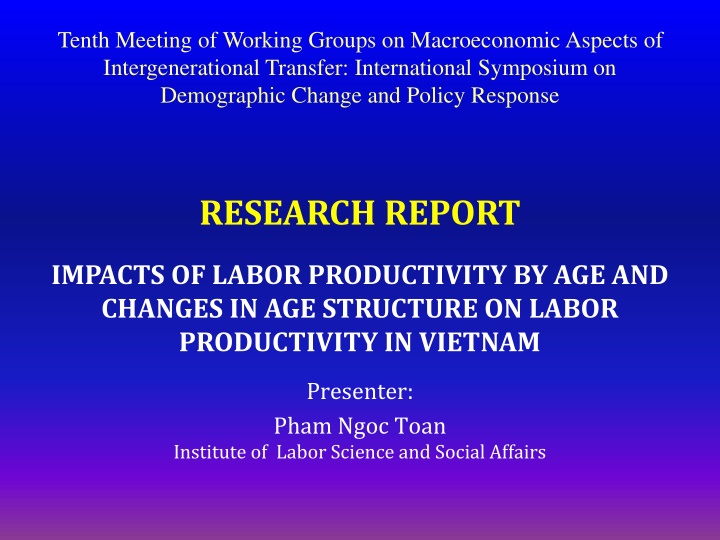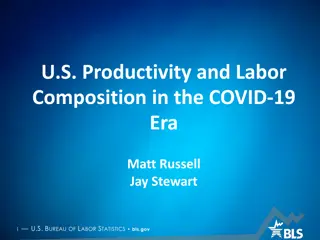Impacts of Labor Productivity by Age and Changes in Age Structure on Labor Productivity in Vietnam
This research focuses on quantifying the impact of labor productivity by age on the overall economy's labor productivity in Vietnam. Utilizing analytical methods like the Cobb-Douglas production function and Shift-Share Analysis, the study aims to understand how changes in age structure and labor shifts influence sectoral productivity and the nation's economic growth potential.
Download Presentation

Please find below an Image/Link to download the presentation.
The content on the website is provided AS IS for your information and personal use only. It may not be sold, licensed, or shared on other websites without obtaining consent from the author.If you encounter any issues during the download, it is possible that the publisher has removed the file from their server.
You are allowed to download the files provided on this website for personal or commercial use, subject to the condition that they are used lawfully. All files are the property of their respective owners.
The content on the website is provided AS IS for your information and personal use only. It may not be sold, licensed, or shared on other websites without obtaining consent from the author.
E N D
Presentation Transcript
Tenth Meeting of Working Groups on Macroeconomic Aspects of Intergenerational Transfer: International Symposium on Demographic Change and Policy Response RESEARCH REPORT IMPACTS OF LABOR PRODUCTIVITY BY AGE AND CHANGES IN AGE STRUCTURE ON LABOR PRODUCTIVITY IN VIETNAM Presenter: Pham Ngoc Toan Institute of Labor Science and Social Affairs
Presentation Contents 1. Rationales and Objectives of the Research 2. Analytical Methods and Data 3. Initial Results 4. Update NTA model in Vietnam 5. Concluding Remarks 6. Discuss to develop NTA model
1. Rationales and Objectives of the Research Rationales Labor productivity is one of the most important factors reflecting national production capacity, and it is measured in various ways. To be comparable, it is usually measured as value-added (VA) per labor. In this measure, however, the role of labor cannot be presented clearly as it is mixed with other factors of production (such as capital, technology, and managerial capacity).
1. Rationales and Objectives of the Research Rationales Total factor productivity (TFP) approach can help to mitigate the above disadvantage in measuring labor productivity, as TFP can separate contributions from capital, labor, and other factors to economic growth. Though, the main disadvantage of TFP approach is that it considers all laborers to have the same productivity, regardless their age, gender, and occupations. This is not true in fact. In addition, labor movements/shifts between economic sectors also result in age structure changes of labor force, which in turn influence sectoral productivity and thus nation's total productivity and potential economic growth.
1. Rationales and Objectives of the Research Objectives This research will: Quantify the impact of labor productivity by age on the economy's labor productivity. Quantify the long-term labor productivity under age-structure changes of population, given an assumption that labor productivity by age will not be changed. How to combine this issues and NTA model
2. Analytical Methods and Data Analytical Methods First, we will apply economic model proposed by Aubert and Cr pon (2007) to quantify labor productivity by age. We will apply Cobb- Douglas production function to calculate labor productivity by age, in which output is presented by value added; capital is presented by total fixed capital; and labor is presented by the number of workers, and is divided into four age groups, including 15-34; 35-55; 56-60, and 61 and over. Second, we will apply Shift-Share Analysis (SSA) method to quantify the impacts of both labor shifts and growth in labor productivity by age on the national labor productivity Third, given an assumption that labor productivity by age will not be changed, the research shows challenges of decreasing labor productivity of the economy in the long-term when population will be rapidly aging.
2. Analytical Methods and Data Analytical Methods Let s start with: (1) -The output created by total labour ( ) is the sum of the outputs created by labour groups which are categorized by age. 0 0 j j L L = + + + ln( ) ln( ) . ln( ) . ln( L . ) Q A K , , , , t i t t i t i t i L . . L L L j j j j j = = + = + 0 . . . . 1 ( 1 ). L L L L 0 0 j j (2) Thus, some researches use following estimation model: L 0 0 L j j + + + ) 1 + Q t ln( ) . ln( ) . log( ) .( Q cons K L Where, is the output (measured by VA, GO or revenue) of enterprise i; input factors include capital Ki and labour contribution ; labour productivity of group j la => The estimation result helps indentify what extent the contribution of each labour unit by age to growth is; it also allows us to measure labour productivity by age. (3) , , , , t i t i t i t i L t i 0 j 0 , i Q L . j
2. Analytical Methods and Data Analytical Methods The research uses Shift-Share Analysis (SSA) method to measure the impact of structure shift by age and productivity growth within each group on the overall labour productivity. P and Pi refer, respectively, to productivity of the economy and productivity of age group i; Y and Yi refer, respectively, to total ouput of the economy created by labour and the output created by age group i; L and Li refer, respectively, to total labour and labour in age group i. The share of labour in age group i in the total labour of the economy is Si. As a results, we have:
2. Analytical Methods and Data Analytical Methods We can calculate as followed: , and = Where: n is the number of age groups. Consequently, absolute change of labour productivity between the base year (year 0) and year t is: The above formular shows that absolute change of labour productivity between the year 0 and year t is caused by three components which are presented in the right side of the formular. They include: -Component 1: Change in productivity of each age group -Component 2: Change in age structure -Component 3: Change in interaction
2. Analytical Methods and Data Data This research will use data from the Enterprise Census from 2010 to 2012, combined with data from the Census on Economic, Administrative Institutions in 2012 to estimate labor productivity by age. This research will also use the results from GSO's population projections for Vietnam in 2009-2049 (GSO, 2011).
3. Initial Results Result of the first model (1) (2) (3) (4) (5) (6) (7) Totlal Agr Mining Manuf E_W_Gas Constr Service Ln(VA) Ln(Capital) 0.235*** 0.455*** 0.305*** 0.279*** 0.395*** 0.297*** 0.210*** (0.032) (0.073) (0.006) (0.052) (0.008) (0.004) (0.003) Ln(Labor) 0.890*** 0.553*** 0.889*** 0.787*** 0.768*** 0.657*** 1.090*** (0.006) (0.056) (0.102) (0.010) (0.086) (0.014) (0.008) Worker share 15-34 0.563*** 0.228 0.447 0.729*** -0.093 -0.204 0.279*** (0.078) (0.610) (2.060) (0.177) (2.442) (0.263) (0.095) 35-55 0.509*** -0.928 0.568 0.737*** -0.666 -0.234 0.349*** (0.081) (0.596) (2.056) (0.183) (2.488) (0.272) (0.099) 56-60 -1.615** -1.049 -2.156 0.00 0.00 0.00 0.00 (0.765) (2.409) (3.044) reference reference reference reference Over 60 -0.614*** -1.488*** -2.428*** -0.544*** 0.00 0.00 0.00 (0.153) (0.395) (0.559) (0.178) reference reference reference Constant 2.693*** 2.374*** 2.024 2.265*** 2.391 3.840*** 2.731*** (0.079) (0.575) (1.900) (0.178) (2.420) (0.269) (0.096) Observations 63,069 934 212 14,005 238 7,664 40,016 R-squared 0.545 0.438 0.578 0.665 0.689 0.464 0.522
3. Initial Results First, on the impact of labor productivity by age on sectoral and national labor productivity. Capital and the number of workers had positive impacts on the growth of value added in all sectors of the economy. In particular, if capital increased by 1%, total value added of all sectors would increase by 0.23%, while that for 1% increase in the number of workers would be 0.89%. As such, given the current growth rates of capital and the number of workers (14%/year and 2%/year, respectively), contribution to value added of all sectors from capital would be 3 percentage points, while that of labor would be 1.6 percentage points. Similar results are also found in some economic sectors, including agriculture, forestry and fishery; mining; manufacturing; electricity, gasoline, steaming, and air conditioning; construction; and services.
3. Initial Results Young and middle-age workers (those aged 15-34 and 35-55, respectively) contributed positively in the growth of sectoral value added: If the proportion of workers aged 15-34 and 35-55 increased by 1 percentage point, the sectoral value added would increase by 0.56% and 0.51%, respectively. Conversely, if the proportion of workers aged 61 and over increased by 1 percentage point, the sectoral value added would decrease by 0.61%. This means that the sectoral labor productivity is not only dependent on labor productivity by age, it is also dependent on the number of workers in each age group: for groups aged 15-34 and 35-55, increasing their workers would increase the sectoral labor productivity, while increasing workers aged 61 and over would reduce the sectoral labor productivity.
3. Initial Results For all sectors, if workers aged 56-60 are considered as the reference group, we found that: labor productivity of those aged 15-34 was about 1.63 times of the reference group's labor productivity; labor productivity of those aged 35-55 was about 1.57 times of the reference group's labor productivity; labor productivity of those aged 61 and over was only 0.32 times of the reference group's labor productivity (Figure 1) Similar results are found for manufacturing and services sectors. Basing on the result of model, we calculate the productivity for each age group i) 1= 1,63 3 means that the labour productivity of 15-34 year old group is 1.63 times of the labour productivity of 56-60 year old group. ii) 2= 1,57 3 means that the labour productivity of 35-55 year old group is 1.57 times of the labour productivity of 56-60 year old group. iii) 4= 0,32 3 means that the labour productivity of the elderly (60 years old and above) is just 0.32 times of the labour productivity of 56-60 year old group.
3. Initial Results Fig 1. Labor productivity by age group, 2010-2012 Unit: VND million per capita 60 2010 2011 2012 50 40 30 20 10 - 15-34 35-54 55-60 60+
3. Initial Results Second, on the impact of labor shifts on the economy's labor productivity in the period 2010-2012 (Table 1) Table 1. Impact of labor shifts on the economy's labor productivity, 2010-12 Labor productivity (VND million per cap.) P(0) Proportion in the total workers (%) Disaggregation of impacts Age group Due to labor productivity change Due to age- structure change Due to combined impacts P(t) S(0) S(t) 2010 2012 2010 2012 15-34 48.04 52.12 44,0 38,9 1.80 -2.46 -0.21 35-54 46.27 50.21 44,4 46,8 1.75 1.14 0.10 55-60 29.47 31.98 5,4 6,6 0.14 0.36 0.03 61+ 9.43 10.23 6,2 7,6 0.05 0.13 0.01 Total 43.85 46.69 100 100 3.73 -0.82 -0.07
3. Initial Results Labor productivity - measured by value added per worker - decreased by age, especially for the group aged 61 and over. Labor productivities of workers in all age groups increased during 2010-2012, and the amount of increase tended to decrease by age. The youngest workers (aged 15-34) had the highest increase (VND 4.08 million), while the oldest workers (aged 61 and over) had the lowest increase (only VND 0.8 million). During 2010-2012, the proportion of the youngest workers (15- 34) decreased by 5 percentage points (from 44% to 39%), while those for other groups slightly increased (less than 3 percentage points). A part of such a trend was that population has changed towards decreasing younger population and increasing middle- age population.
3. Initial Results As a result: changes in the sectoral labor productivity were mostly due to changes in ages structure of workers and labor shifts between sectors, but not due to the combined impacts of these factors. Remarkably, the youngest workers had the highest labor productivity and contributed for nearly 50% of the change in the sectoral labor productivity (VND 1.8 million out of VND 3.73 million), but this group made the sectoral labor productivity reduced in terms of age structure changes (a reduction at about 3 times of that of the sectoral labor productivity: VND 2.46 million compared to VND 0.82 million). The main reason for such a finding was that the proportion of the youngest workers (aged 15-34) - those who had the highest labor productivity - reduced the most.
3. Initial Results Third, given an assumption that labor productivity by age will be changed, the simulation results for the impacts of population's age structure changes on the national labor productivity show that aging population would have negative impacts on the national labor productivity in the long-term (Fig 2). Figure 2. Increases in labor productivity, by age and for the whole economy, 2009-2049 0.400 0.200 0.000 2013 2014 2015 2016 2017 2018 2019 2020 2021 2022 2023 2024 2025 2026 2027 2028 2029 2030 2031 2032 2033 2034 2035 2036 2037 2038 2039 2040 2041 2042 2043 2044 2045 2046 2047 2048 2049 -0.200 -0.400 -0.600 -0.800 -1.000 15-34 35-54 55-60 60+ Change in structural age
3. Initial Results Fourth, given an assumption that labor productivity by age will be changed, the simulation results for the impacts of productivity's age group changes on the national labor productivity. (Fig 3). Figure 3. Increases in national labor productivity, by productivity s age group change, 2009-2049 8.000 7.000 6.000 5.000 4.000 3.000 2.000 1.000 0.000 2013 2014 2015 2016 2017 2018 2019 2020 2021 2022 2023 2024 2025 2026 2027 2028 2029 2030 2031 2032 2033 2034 2035 2036 2037 2038 2039 2040 2041 2042 2043 2044 2045 2046 2047 2048 2049 2050 15-34 35-54 55-60 60+ Change in Productivity
3. Initial Results Fifth, Population s age structure change will have negative impact on total productivity, but change in productivity at each group will have positive impact. (Fig 4). Figure 4. The contribution of productivity s age group change and population s age structure change to national labor productivity, 2009-2049 9.000 8.000 7.000 6.000 5.000 4.000 3.000 2.000 1.000 0.000 2013 2014 2015 2016 2017 2018 2019 2020 2021 2022 2023 2024 2025 2026 2027 2028 2029 2030 2031 2032 2033 2034 2035 2036 2037 2038 2039 2040 2041 2042 2043 2044 2045 2046 2047 2048 2049 -1.000 -2.000 Total Change in structural age Change in Productivity
4. Update NTA model in Vietnam The new data: - Input Output Table 2012 -Vietnam Household living Standard Survey in 2012 Figure 5. Labor income and Expenditure by age 60,000 50,000 40,000 30,000 20,000 10,000 - 0 5 10 15 20 25 30 35 40 45 50 55 60 65 70 75 80 85 90+ Consumption 2012 Labor Income 2012
4. Update NTA model in Vietnam Fig. 6Growth rate of Economic Support Ratio of Vietnam. Changes of population structure can positively contribute to growth until 2019. 0.6 0.4 0.2 0.0 2005 2010 2015 2020 2025 2030 2035 2040 2045 2050 -0.2 -0.4 -0.6
5. Concluding Remarks The research also indicated that age-structure changes of population toward aging would have significant impacts on labor productivity. Efficient utilization of labor by age will help to maximize workers potential productivity. In particular for young workers as the leader in productivity should we provide them sufficient investment in education, health, skills, etc. Age-structure changes of population toward aging will provide both opportunities and challenges for promoting economic growth and accumulation for the country.
6. Discussion Research limitation : Data only collects from formal sector, not from informal sector => built the weight for them to adjust productivity at each age group The result depend on assumption of change in productivity at each age group How to connect the productivity at each age group and NTA model























